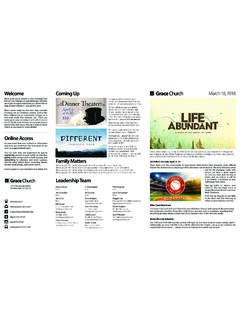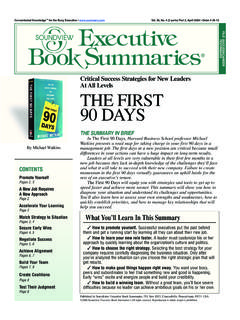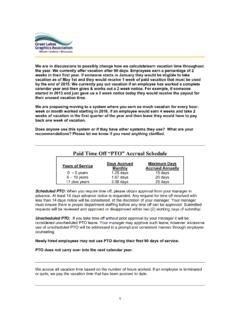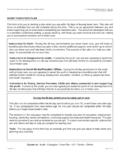Transcription of The First 90 Days Critical Success Strategies For New ...
1 Ss The First 90 days Critical Success Strategies For New Leaders At All Levels by Michael Watkins Whether challenged with taking on a startup, turning a business around, or inheriting a high-performing unit, a new leader's Success or failure is determined within the First 90 days on the job. New leaders are expected to hit the ground running. Unfortunately many of them are left to sink or swim in this Critical period. With his bestselling book, The First 90 days , author Michael Watkins offers proven Strategies for moving successfully into a new role at any point in one's career. Watkins provides a framework to help leaders diagnose their situation, craft winning transition Strategies , and take charge quickly. By defining five main focus points and providing step by step action plans to jumpstart their Success , Watkins helps new leaders build a personal transition blueprint to build early victories and achieve long-term Success no matter what type of leadership position they pursue.
2 Focus point one, Assessing Your Strengths and Weaknesses, teaches leaders how to match their strengths to their new position and shows them how to create a learning plan to become more knowledgeable about their company and position. With focus point two, Diagnosing Your Situation, leaders learn how to accurately identify the challenges associated with their new position and how to match their learning plan to those challenges. Focus point three, Securing Early Wins, centers around building creditability and identifying ways to improve business results. With focus point four, Negotiating With Your Boss, leaders learn how to develop a productive working relationship with their new boss and gain crucial support within the First three months. Finally, with focus point five, Building Your Team, leaders are given the tools to evaluate their current team and create a new team that can help them accomplish their goals.
3 So now let's learn Watkins' Strategies for avoiding the most common pitfalls new leaders encounter and how they can prepare themselves for this intense and vulnerable period. Focus Point 1: Assessing Your Strengths and Weaknesses Before you can find Success in your new position you must First examine your strengths and determine how they can support you in your new role. However, you will also need to pinpoint your weaknesses, especially those that pertain specifically to your new responsibilities, so that you can devise a learning strategy that will help you transition quickly and efficiently. To begin determining your strengths you need to take a look at the successes you enjoyed in your previous position that helped you win your new position. What 1 | The Business Source All Rights Reserved Ss talents brought you the most Success ?
4 For example, was it your knack for product placement, your ability to increase employee morale, or your wizardry with budgeting that was the key selling point for promotion to your new position? Once you have determined your key strengths you need to determine how those abilities will help in your new position and also how they could be a problem for you in the future. For example, if one of your key strengths is your unwavering attention to detail you may need to work on pulling back a little, especially if your new position calls for a more hands-off approach to management. This "strength". could be interpreted as micro-managing your team members and result in stifling their contributions. Second, you need to identify any weaknesses you may have in relation to your new position.
5 For example, if your previous position required that you excel in employee relations but never called for expertise in facilitating organizational operations between departments, you may need to acquire these skills. Once you have determined your main strengths and weaknesses and pinpointed the areas that you need to improve on, it is time to develop a learning strategy. Start by reading available material about the company's people, performance, strategy, and structure. Next speak to your new boss about the history, culture, and politics of the organization. Finally, review the operating plans, performance data, and personnel data that relates to your position. Once your research is done, compile a list of items that you need to explore further in order to be better prepared to tackle your new position.
6 For example, as the new head of HR you may learn that the company has a fairly successful reward and incentives plan in place for employees, but that in recent years popular opinion of this program has plummeted. If employee incentives are not your strength you will need to add this area to your learning strategy. Read books on HR responsibilities, research incentive programs established by other successful businesses, and talk to key employees to get their input concerning an incentive program overhaul. In order to devise the most successful learning strategy, ask yourself the following questions. 1. What Critical skills do you need to develop First to make the biggest contribution to your new position? Example answers include: becoming more cost-conscious, increasing understanding of the management of financial risk, and learning more about cross-functional cooperation.
7 2. Who can you seek advice and insight from to better develop your learning strategy? For example, can your new boss guide you in determining the areas that need the most focus in your First ninety days ? Can you meet with the former holder of this position and inquire about areas of suggested focus? Is there a colleague who may hold insight on your new responsibilities? 2 | The Business Source All Rights Reserved Ss 3. Where can you devote the most learning time in order to make the biggest impact? Managers of business units may want to conduct plant tours or process analysis in order to assess technical capabilities, the efficiency of current process, and the overall climate of the business. HR leaders may want to organize focus groups and discuss employee morale, interdepartmental cooperation factors, and leadership concerns in order to better prepare new Strategies for the First ninety days .
8 Focus Point 2: Diagnosing Your Situation Once you have researched the Critical areas in your new position and determined the most successful learning strategy to address them, you need to diagnose the situation and explore ways that you can initiate the right types of change without making enemies. One common failure factor shared by new leaders is the tendency to rush to change once an idea seems solid before determining how the change will affect the company culture. Making changes without an understanding of the organization's politics can lead to loss of support and eventual failure. In order to complete a thorough and accurate diagnosis you need to answer a few questions. 1. What type of business situation are you entering into? The four main situations include start-up, turnaround, realignment, and sustaining.
9 With a start-up situation your main focus will be the building of a product or company. In a turnaround situation your focus will be on taking what is bad or failing about the organization and appropriating changes that will lead to Success . For a realignment situation you will focus on revising an area that is headed for trouble and leading it in the right direction. Finally, with a sustaining situation your focus will be on nurturing the factors that have led to company-wide prosperity and adding your own strengths to further that Success and take the business to the next level. Identifying new market areas or initiating an employee benefit program would be good focus points at a start-up. However, identifying small changes in processes like product delivery that can quickly show financial improvements is a better focus point area in turnaround situations.
10 2. What challenges exist because of your particular business situation? If you have taken over as a manager in a start-up situation you may be faced with developing the processes of an entire team and setting them on the path to growth. On the other hand, if you are a new manager in a turnaround situation your biggest challenge may be increasing employee morale while making tough decisions regarding personnel cuts. 3. What is the climate in your new business situation? Before you can point out areas of improvement and initiate change you will need to gauge the psychological frame of mind of the organization. Is the company ready for change? How do they view your position? Test the waters with a focus group or by interviewing key employees and then tailor your strategy to include their opinions and feelings.



















